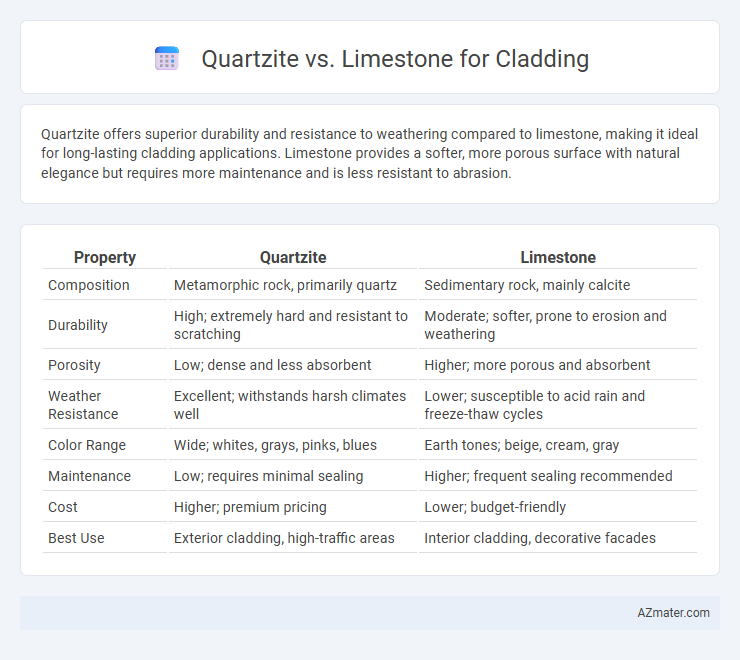Quartzite offers superior durability and resistance to weathering compared to limestone, making it ideal for long-lasting cladding applications. Limestone provides a softer, more porous surface with natural elegance but requires more maintenance and is less resistant to abrasion.
Table of Comparison
| Property | Quartzite | Limestone |
|---|---|---|
| Composition | Metamorphic rock, primarily quartz | Sedimentary rock, mainly calcite |
| Durability | High; extremely hard and resistant to scratching | Moderate; softer, prone to erosion and weathering |
| Porosity | Low; dense and less absorbent | Higher; more porous and absorbent |
| Weather Resistance | Excellent; withstands harsh climates well | Lower; susceptible to acid rain and freeze-thaw cycles |
| Color Range | Wide; whites, grays, pinks, blues | Earth tones; beige, cream, gray |
| Maintenance | Low; requires minimal sealing | Higher; frequent sealing recommended |
| Cost | Higher; premium pricing | Lower; budget-friendly |
| Best Use | Exterior cladding, high-traffic areas | Interior cladding, decorative facades |
Introduction to Quartzite and Limestone Cladding
Quartzite cladding offers exceptional durability and resistance to weathering, making it ideal for exterior surfaces exposed to harsh conditions. Limestone cladding provides a softer, more porous texture that enhances aesthetic appeal while requiring regular maintenance to prevent erosion. Both materials serve distinct architectural styles, with quartzite favored for modern, rugged facades and limestone preferred in traditional, classic designs.
Key Differences Between Quartzite and Limestone
Quartzite is a hard, metamorphic rock formed from sandstone, characterized by high durability, resistance to weathering, and a glassy, crystalline appearance, making it ideal for exterior cladding in harsh environments. Limestone, a sedimentary rock composed mainly of calcium carbonate, offers a softer texture with a matte finish and is more prone to erosion and staining, requiring regular maintenance for cladding applications. Quartzite's superior hardness (7 on Mohs scale) contrasts with limestone's lower hardness (3-4 on Mohs scale), impacting longevity and suitability in high-traffic or exposed areas.
Aesthetic Appeal: Texture, Color, and Finish Comparison
Quartzite offers a striking aesthetic appeal with its durable, natural crystalline texture that reflects light, providing a lustrous finish ideal for modern cladding applications. Limestone features a softer, matte surface with warm earthy tones ranging from creamy whites to rich beiges, creating a classic and timeless look in architectural design. While quartzite's color spectrum often includes subtle grays and blues enhancing contemporary styles, limestone's porous nature allows for versatile finishes, including honed or rougher textures that add depth and character to building exteriors.
Durability and Weather Resistance
Quartzite offers superior durability and weather resistance compared to limestone due to its high hardness and low porosity, making it an ideal choice for exterior cladding exposed to harsh conditions. Limestone's softer composition and higher porosity result in greater susceptibility to erosion, staining, and weathering over time, necessitating more frequent maintenance. The natural resistance of quartzite to abrasion, freeze-thaw cycles, and chemical damage ensures long-lasting performance in diverse climates.
Maintenance Requirements for Each Material
Quartzite cladding requires minimal maintenance due to its high resistance to scratching, staining, and weathering, making it ideal for durable, long-lasting exterior surfaces. Limestone, being more porous and softer, demands regular sealing and careful cleaning to prevent moisture absorption, staining, and erosion over time. Both materials benefit from periodic inspections, but quartzite's superior hardness significantly reduces ongoing maintenance efforts compared to limestone.
Installation Process and Challenges
Quartzite cladding requires specialized cutting tools due to its high hardness, which can increase installation time and labor costs. Limestone is easier to cut and shape, facilitating faster installation but demands careful handling to prevent chipping and surface damage. Both materials need proper substrate preparation and moisture barriers to avoid long-term durability issues in cladding applications.
Cost Analysis: Quartzite vs Limestone
Quartzite generally commands a higher price than limestone due to its superior durability and natural resistance to weathering, making it a costlier option for cladding projects. Limestone, being more abundant and easier to quarry and process, tends to offer a more budget-friendly solution with moderate maintenance requirements. When evaluating total cost of ownership, quartzite's longevity and low maintenance can offset its initial expense compared to the more affordable but softer and more porous limestone.
Sustainability and Environmental Impact
Quartzite offers superior durability and resistance to weathering, reducing the need for frequent replacements and lowering environmental impact over time compared to limestone. Limestone's extraction process often results in higher carbon emissions and habitat disruption due to extensive quarrying and chemical treatments required for durability. Selecting quartzite for cladding supports sustainability by minimizing resource consumption and enhancing the lifespan of building facades in eco-friendly construction projects.
Best Applications for Quartzite and Limestone Cladding
Quartzite cladding excels in exterior applications due to its superior hardness, weather resistance, and ability to withstand freeze-thaw cycles, making it ideal for facades, retaining walls, and outdoor fireplaces. Limestone cladding is best suited for interior environments or mild climates where its softer texture and natural porosity provide aesthetic warmth and ease of carving for detailed architectural features. Both materials complement modern and classical designs, but quartzite's durability favors high-traffic or exposed areas while limestone enhances decorative elements with its subtle color variations.
Choosing the Right Stone: Which Is Better for Your Project?
Quartzite offers superior durability and resistance to weathering, making it an excellent choice for exterior cladding where long-term performance is critical. Limestone provides a softer, more natural aesthetic with easier workability, suited for interior or decorative cladding applications where appearance and texture are prioritized. Selecting between quartzite and limestone depends on the specific requirements of your project, including environmental exposure, desired finish, and maintenance expectations.

Infographic: Quartzite vs Limestone for Cladding
 azmater.com
azmater.com